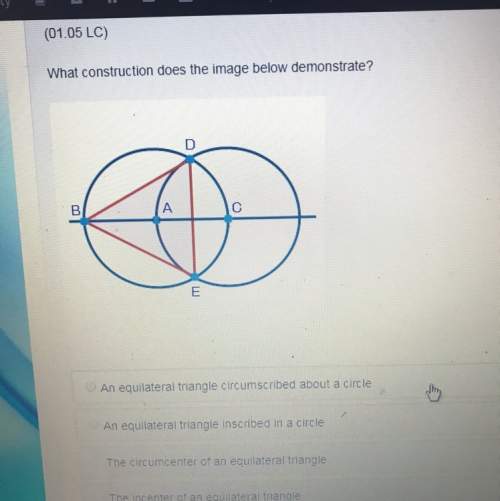
Mathematics, 07.07.2019 00:50 alissiabenner4087
1. the square of a number, n, is equal to the sum of that number and 11. which equation represents this relationship? a. 2n = n + 11 b. (n + 11)2 = n +11 c. n2 = n + 11 d. 2n = n − 11 2. which inequality represents the statement below? four less than 6 times n is more than 20. a. 4n > 20 b. n - 4 > 20 c. 6n - 21 > 4 d. 6n - 4 > 20

Answers: 1


Another question on Mathematics

Mathematics, 21.06.2019 15:20
Acourgette seed and a pumpkin seed is planted p(courgette seed germinates) 4/5 and p(pumpkin seed germinates) = 1/6 what is the probability that both seds germinate
Answers: 2

Mathematics, 21.06.2019 17:00
Use the frequency distribution, which shows the number of american voters (in millions) according to age, to find the probability that a voter chosen at random is in the 18 to 20 years old age range. ages frequency 18 to 20 5.9 21 to 24 7.7 25 to 34 20.4 35 to 44 25.1 45 to 64 54.4 65 and over 27.7 the probability that a voter chosen at random is in the 18 to 20 years old age range is nothing. (round to three decimal places as needed.)
Answers: 1

Mathematics, 21.06.2019 18:00
What is the equation of this graphed line? enter your answer in slope-intercept form in the box.
Answers: 2

Mathematics, 21.06.2019 18:30
The border line of the linear inequality 4x + 7y < 5 is dotted true or false?
Answers: 2
You know the right answer?
1. the square of a number, n, is equal to the sum of that number and 11. which equation represents t...
Questions





Mathematics, 26.10.2020 21:30




Mathematics, 26.10.2020 21:30



English, 26.10.2020 21:30



Computers and Technology, 26.10.2020 21:30

Mathematics, 26.10.2020 21:30




Mathematics, 26.10.2020 21:30




